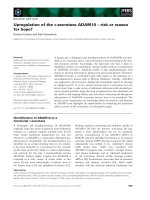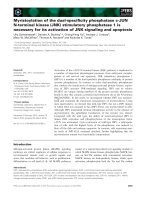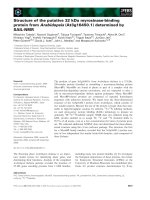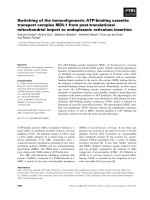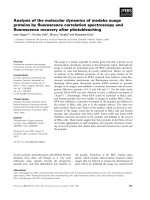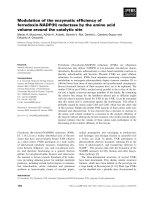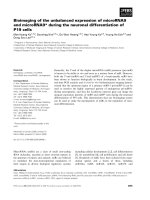Báo cáo khoa học: Retention of the duplicated cellular retinoic acid-binding protein 1 genes (crabp1a and crabp1b) in the zebrafish genome by subfunctionalization of tissue-specific expression doc
Bạn đang xem bản rút gọn của tài liệu. Xem và tải ngay bản đầy đủ của tài liệu tại đây (756.5 KB, 11 trang )
Retention of the duplicated cellular retinoic acid-binding
protein 1 genes (crabp1a and crabp1b) in the zebrafish
genome by subfunctionalization of tissue-specific
expression
Rong-Zong Liu
1
, Mukesh K. Sharma
1
, Qian Sun
1
, Christine Thisse
3
, Bernard Thisse
3
,
Eileen M. Denovan-Wright
2
and Jonathan M. Wright
1
1 Department of Biology, Dalhousie University, Halifax, Nova Scotia, Canada
2 Department of Pharmacology, Dalhousie University, Halifax, Nova Scotia, Canada
3 Institut de Ge
´
ne
´
tique et Biologie Mole
´
culaire et Cellulaire, Department of Developmental Biology, UMR 7104, CNRS ⁄ INSERM ⁄ ULP,
CU de Strasbourg, Illkirch, France
Cellular retinoid-binding proteins belong to the large
family of low molecular mass ( 15 kDa) intracellular
lipid-binding proteins (iLBP) that bind fatty acids, reti-
noids and steroids [1–3]. In mammals, two different
groups of cellular retinoid-binding proteins with dis-
tinctive binding properties have been identified, the
cellular retinol-binding proteins (CRBPs) and the cel-
lular retinoic acid-binding proteins (CRABPs). CRBPs,
including CRBPI, CRBPII, CRBPIII and CRBPIV,
show greatest binding affinity for retinol and retinal,
but do not bind retinoic acid or retinyl esters [1,4–6].
In contrast, the mammalian CRABPs, CRABPI and
CRABPII, bind retinoic acid but not retinol or retinal.
However, the affinity of the rat CRABPI for all-trans
RA (K
d
¼ 4nm) is much greater than that of CRAB-
PII (K
d
¼ 64 nm), and the same relative affinity for
Keywords
crabp1; embryonic development; gene
duplication; gene expression;
subfunctionalization
Correspondence
J. M. Wright, Department of Biology,
Dalhousie University, Halifax, Nova Scotia,
Canada, B3H 4J1
Fax: +1 902 4943736
Tel: +1 902 4946468
E-mail:
Website: />(Received 4 March 2005, revised 2 May
2005, accepted 16 May 2005)
doi:10.1111/j.1742-4658.2005.04775.x
The cellular retinoic acid-binding protein type I (CRABPI) is encoded by a
single gene in mammals. We have characterized two crabp1 genes in zebra-
fish, designated crabp1a and crabp1b. These two crabp1 genes share the
same gene structure as the mammalian CRABP1 genes and encode proteins
that show the highest amino acid sequence identity to mammalian CRAB-
PIs. The zebrafish crabp1a and crabp1b were assigned to linkage groups 25
and 7, respectively. Both linkage groups show conserved syntenies to a seg-
ment of the human chromosome 15 harboring the CRABP1 locus. Phylo-
genetic analysis suggests that the zebrafish crabp1a and crabp1b are
orthologs of the mammalian CRABP1 genes that likely arose from a teleost
fish lineage-specific genome duplication. Embryonic whole mount in situ
hybridization detected zebrafish crabp1b transcripts in the posterior hind-
brain and spinal cord from early stages of embryogenesis. crabp1a mRNA
was detected in the forebrain and midbrain at later developmental stages.
In adult zebrafish, crabp1a mRNA was localized to the optic tectum,
whereas crabp1b mRNA was detected in several tissues by RT-PCR but
not by tissue section in situ hybridization. The differential and complement-
ary expression patterns of the zebrafish crabp1a and crabp1b genes imply
that subfunctionalization may be the mechanism for the retention of both
crabp1 duplicated genes in the zebrafish genome.
Abbreviations
CRABPIa and CRABPIb, cellular retinoic acid-binding protein type I a and b; CRBP, cellular retinol-binding protein; hpf, hours post fertilization;
iLBP, intracellular lipid-binding protein; LG, linkage group; ORF, open reading frame; RA, retinoic acid.
FEBS Journal 272 (2005) 3561–3571 ª 2005 FEBS 3561
all-trans retinoic acid (RA) is also true for human
CRABPI (K
d
¼ 0.06 nm) and CRABPII (K
d
¼
0.13 nm) [7].
The function of mammalian CRABPI is not fully
understood. The highly conserved amino acid seq-
uence of CRABPI among different species and its
distinct tissue-specific expression patterns during
development and in adulthood suggest that it has an
essential role in retinoic acid targeting and metabo-
lism. Homozygous CRABPI knockout mice, however,
exhibit no overt abnormalities and appear essentially
normal in terms of viability and fertility [8–10]. As
such, CRABPI function may be dispensable or com-
pensated by another member of the CRABPI ⁄ CRAB-
PII multigene family in these knockout mice. A
recent investigation of CRABPI function using a
murine embryonic stem cell line deleted for crabp1
showed that homozygous deletion of this gene results
in decreased intracellular RA concentrations and
increased CRABPII expression suggesting a role for
CRABPI in the RA homeostasis in cells and regula-
tion of CRABPII expression [11]. Further evidence
that CRABPI may modulate RA signaling is the
localization of CRABPI in both the cytoplasm and
nucleus [12–14]. Specific expression of CRABPI in the
mammalian olfactory bulb and spinal cord, which are
recognized as prominent sites of ongoing plasticity
and response to RA, implies that CRABPI is
involved in neurogenesis [15–18].
The mammalian CRABPI and CRABPII proteins
are encoded by single genes which, like all other para-
logous members of the vertebrate iLBP family, consist
of four exons separated by three introns [1]. Except for
the gene structure of CRABPI in pufferfish (Fugu rubr-
ipes) [19], no detailed characterization of CRABPI
genes has been reported in fishes, the largest and most
diverse group of vertebrates. Furthermore, only a sin-
gle copy of the gene encoding CRABPI has been iden-
tified in vertebrates. Here we report the finding of
duplicated genes coding for CRABPI (designated
crabp1a and crabp1b) in the zebrafish genome. Gene
structure, syntenic relationship and primary protein
sequence of the zebrafish crabp1a and crabp1b are
well conserved with their orthologous mammalian
CRABP1s. Comparative genomic analysis suggests that
the zebrafish duplicated crabp1a and crabp1b genes
may have arisen from a teleost fish-specific chromoso-
mal or whole genome duplication. The differential
distribution of crabp1a and crabp1b transcripts during
development and in adult zebrafish tissues implies
subfunctionalization after their duplication, which
might be a mechanism for preservation of the crabp1
duplicates in the zebrafish genome.
Results
Determination of cDNA sequence and gene
structure of the zebrafish crabp1a
A zebrafish EST sequence (GenBank accession number
BI533516) showing sequence similarity to the mamma-
lian CRABPI was identified and retrieved from the
GenBank database. Complete and overlapping 3¢ and
5¢ cDNA ends of the putative zebrafish crabp1 (desig-
nated crabp1a) were PCR-amplified using primers
based on the EST sequence, cloned and sequenced.
The zebrafish crabp1a cDNA sequence was 719 bp
including a 56 bp 5¢-UTR and a 246 bp 3¢-UTR (Gen-
Bank accession number AY242125). A polyadenylation
signal was located 14 bp upstream of the poly A tail
in the cDNA clones. A 417 bp open reading frame
(ORF) for the zebrafish crabp1a cDNA was identified,
which codes for a peptide of 138 amino acids with a
theoretical molecular mass of 15.68 kDa and a predic-
ted isoelectric point of 5.05. The deduced amino acid
sequence of the zebrafish CRABPIa showed highest
identity with the mammalian and pufferfish CRABPIs
(84–86%) (Fig. 1A), followed by mammalian and
zebrafish CRABPIIs (58–69%), mammalian and zebra-
fish CRBPIs (28–34%), mammalian and zebrafish
CRBPIIs (28–30%), human CRBPIII (29%) and
CRBPIV (30%) (data not shown). Comparison of the
amino acid sequence of the zebrafish CRABPIa with
its mammalian and pufferfish orthologs showed that
there is a proline insertion in the amino acid sequence
immediately following the initiator methionine
(Fig. 1A).
Sequenced genomic DNA segments with identity to
the cloned cDNA of the zebrafish crabp1a were identi-
fied by a BlastN search and retrieved from the zebra-
fish genome database (Wellcome Trust Sanger
Institute). An assembly (GenBank accession number
BX296538) contained the sequence of exon 1 (129 bp),
intron 1 (5828 bp), exon 2 (179 bp), a part of intron 2
and a 5¢ upstream sequence of crabp1a. A scaffold
sequence, Zv4_scaffold2030.1, harbored the sequence
of both exon 3 (114 bp), intron 3 (3262 bp) and exon
4 (298 bp), and part of the sequence for intron 2. The
cDNA and genomic DNA sequences showed differ-
ences between three nucleotides in exon 2, resulting in
alteration of the 15th codon of exon 2 from GCC to
GCA, 44th codon CGT to CGC and 47th codon GAA
to GAG. In spite of these nucleotide differences, the
amino acids encoded by these codons remained
unchanged suggesting that these changes represent
allelic variants. The RNA donor and acceptor splice
sites present in each intron of the zebrafish crabp1a
Duplicated crabp1 genes in zebrafish R Z. Liu et al.
3562 FEBS Journal 272 (2005) 3561–3571 ª 2005 FEBS
gene conformed to the GT-AG rule [20]. The zebrafish
crabp1a gene structure, consisting of four exons
and three introns, is the same as the mammalian and
pufferfish crabp1 genes (Fig. 1B). Exon 1 of the
crabp1a genomic sequence, like the cDNA sequence,
had an insertion of a proline codon (CCT) immedi-
ately following the initiator methionine relative to
mammalian and pufferfish orthologs [1,19].
5¢-RLM-RACE generated a single product corres-
ponding to the position of the 7-methyl G cap of the
mature crabp1a mRNA (data not shown). Alignment
of the nucleotide sequence of the cloned 5¢-RLM-
RACE product with the genomic sequence assigned
the transcription start site to the 56 bp upstream of
the initiation codon (data not shown).
Identification of a second crabp1 gene, crabp1b
A tblastn search using the deduced amino acid
sequence of the zebrafish CRABPIa as a query identi-
fied a second crabp1-like gene in the zebrafish genome
(GenBank accession number BX663612). This gene
codes for an amino acid sequence showing similarity
to the zebrafish CRABPIa and the mammalian CRAB-
PIs (Fig. 1A). The structure and coding capacity of
this gene was identical to that of the mammalian and
A
B
Exon 1 Intron 1 Exon 2 Intron 2 Exon 3 Intron 3 Exon 4
24 aa 60 aa 38 aa 16 aa
5828 bp 3262 bp
23 aa 60 aa 38 aa 16 aa
7629 bp 6815 bp 7470 bp
23 aa 60 aa 38 aa 16 aa
1959 bp 3453 bp 1222 bp
23 aa 60 aa 38 aa 16 aa
554 bp 2277 bp 4313 bp
23 aa 60 aa 38 aa 16 aa
511 bp 2925 bp 4328 bp
Fig. 1. Alignment of the amino acid sequences of the fish and mammalian CRABPIs and comparison of their gene structures. (A) Zebrafish
(Zf) CRABPIa (GenBank accession number: AAP44333) and CRABPIb (AAT38218) were aligned with the pufferfish (Pf; O42386), human
(Hm; P29762) and mouse (Ms; P02695) CRABPIs. Dots indicate amino acid identity and dashes represent gaps. Positions of amino acids are
marked and numbered. Amino acid sequence identity values between the zebrafish CRABPIs and the pufferfish, human and mouse CRAB-
PIs are indicated at the end of each alignment. A proline insertion in the zebrafish CRABPIa is indicated by a ‘.’. (B) Comparison of the exo-
n ⁄ intron organization of the zebrafish (Zf) crabp1 genes with the orthologous genes from pufferfish (Pf), human (Hm) and mouse (Ms).
Exons are shown as boxes and introns as lines. The number of amino acids encoded by each exon is shown above the boxes. The size of
each complete intron is indicated. The complete sequence of the second intron in crabp1a has not been determined (indicated by dashes).
The human and mouse CRABP1 gene sequences were obtained from GenBank (accession numbers NT_086829 and NT_039474). The struc-
ture of the pufferfish crabp1 gene was defined based on reference [19].
R Z. Liu et al. Duplicated crabp1 genes in zebrafish
FEBS Journal 272 (2005) 3561–3571 ª 2005 FEBS 3563
pufferfish CRABP1 genes (Fig. 1B). We designated this
gene as crabp1b.5¢-RLM-RACE located a single tran-
scription start site 109 bp upstream of the initiation
codon (data not shown). The zebrafish crabp1b gene
was approximately 23 kb in length (Fig. 1B).
The complete cDNA sequence of the zebrafish
crabp1b (GenBank accession number AY616861) was
determined by sequencing cloned 5¢-RLM-RACE and
3¢-RACE products. The primers used for the cDNA
cloning were designed based on the coding sequence of
the zebrafish crabp1b gene. The length of the complete
cDNA sequence was 895 bp excluding the poly(A) tail.
A polyadenylation signal was identified in the 3¢-UTR
13 nucleotides upstream of the polyadenylation site.
The cDNA sequence contained an ORF of 414 bp
coding for a polypeptide of 137 amino acids. The
deduced amino acid sequence of the zebrafish CRAB-
PIb showed highest identity to the zebrafish CRABPIa
(88%) and the mammalian and pufferfish CRABPIs
(84–85%) (Fig. 1A), lower sequence identity to the
mammalian and fish CRABPIIs (58–71%) and lowest
identity to the mammalian and fish CRBPs (25–35%)
(data not shown).
The crabp1a and crabp1b genes arose from
a fish-specific chromosomal duplication
Phylogenetic analysis of the mammalian and fish cellu-
lar retinoid-binding proteins revealed two distinct
clades: CRBPs and CRABPs (Fig. 2). The zebrafish
CRABPIa and CRABPIb clustered with the mamma-
lian and pufferfish CRABPIs in the same clade with a
robust bootstrap value of 998 ⁄ 1000. The gene phylo-
geny suggests that the zebrafish crabp1a and crabp1b
are orthologs of the mammalian and pufferfish genes
for CRABPI, which may have arisen from a fish-speci-
fic chromosomal or whole genome duplication after
the divergence of the tetrapod and fish lineages some
300 million years ago [21].
Linkage group (LG) assignment of the zebrafish
crabp1 genes was determined by radiation hybrid map-
ping using the LN54 panel [22]. The zebrafish crabp1a
gene was assigned to LG 25 with a mapping distance
of 26.53 cR to marker Z7306, while crabp1b was
assigned to LG 7 at a site 2.94 cR to marker fd15c06
(mapping data available on request). Both zebrafish
crabp1 genes displayed conserved syntenies with the
human CRABP1 gene on chromosome 15 (15q24)
([23]; (Fig. 3). The
conserved syntenies on the human chromosome 15
with both zebrafish crabp1 genes were distributed
within the same chromosomal region 15q15–15q26
(Fig. 3). Another pair of duplicated zebrafish genes,
foxb1.1 and foxb1.2, were also found to be located on
the zebrafish LG 7 and LG 25, respectively. The single
human orthologous FOXB1 gene is located at position
15q21-q26.
Differential distribution of the crabp1a and
crabp1b transcripts during embryonic and larval
development
The spatio-temporal distribution of the zebrafish
crabp1a and crabp1b transcripts during embryonic and
Fig. 2. Phylogenetic analysis of cellular retinoid-binding proteins.
The bootstrap neighbor-joining phylogenetic tree was constructed
using
CLUSTALX [23]. The zebrafish (Zf) intestinal type fatty acid-bind-
ing protein (I-FABP) amino acid sequence (GenBank accession num-
ber AAF00925) served as an outgroup. The bootstrap values (based
on number per 1000 replicates) are indicated to the right of each
node. Amino acid sequences used in this analysis include zebrafish
CRBPIa (AAQ54326), zebrafish CRBPIb(AAR31829), human (Hm)
CRBPI (P09455), mouse (Ms) CRBPI (Q00915), rat (Rt) CRBPI
(P02696), zebrafish CRBPIIa (AAL38648), zebrafish CRBPIIb
(AAT40241), human CRBPII (P50120), mouse CRBPII (Q08652), rat
CRBPII (P06768), human CRBPIII (P82980), human CRBPIV
(AAN61071), zebrafish CRABPIa (AAP44333) and CRABPIb
(AAT38218), human CRABPI (P29762), mouse CRABPI (P02695),
pufferfish (Pf) CRABPI (O42386), zebrafish CRABPIIa (AAQ85530),
zebrafish CRABPIIb (AAW23987), human CRABPII (P29373),
mouse CRABPII (P22935), and rat CRABPII (P51673). Scale bar ¼
0.1 substitutions per site.
Duplicated crabp1 genes in zebrafish R Z. Liu et al.
3564 FEBS Journal 272 (2005) 3561–3571 ª 2005 FEBS
larval development was determined by whole mount
in situ hybridization (Figs 4 and 5). The two duplicate
paralogous genes showed differential and mostly non-
overlapping mRNA distribution patterns in the devel-
oping CNS. The zebrafish crabp1b transcripts were
detected during the middle somitogenesis stage at 17 h
post fertilization (hpf) in the primary neurons through-
out the spinal cord and the trigeminal placode
(Fig. 4A1–3). At 24 hpf, crabp1a mRNA was first
detected in the neurohypophysis and the epidermis of
the tail bud (Fig. 4B1–3). In comparison, crabp1b
mRNA-specific hybridization signal was distributed
in the anterior and posterior spinal cord, ventro-lateral
part of rhombomere 7 in the posterior hindbrain, vent-
ral part of the anterior somites, hypaxial muscles and
the tail bud (Fig. 4B4–6 and 4C1–4). A weak crabp1b-
specific hybridization signal was present in rhombo-
mere 6 (Fig. 4B6) and posterior yolk syncytial layer
(Fig. 4B4). At 36 hpf, hybridization signals for crabp1a
mRNA were observed in the nucleus of the diencepha-
lon, the ventricular zone of the developing optic tec-
tum and the dorsal retina, the epidermis of the tail tip
in addition to neurohypophysis (Fig. 5A,C,E). crabp1b
transcripts were abundantly distributed in the posterior
hindbrain and anterior spinal cord in which the signal
was restricted to the dorsal spinal cord and gradually
diminished along the length of the spinal cord
(Fig. 5B,F). The hybridization signal in the ventral
part of the anterior somites, hypaxial muscles and tail
tip showed the presence of crabp1b mRNA in these
tissues (Fig. 5B,D,F). At 48 hpf, crabp1a transcripts
were detected in the nucleus of the diencephalons,
optice tectum and neurohypophysis (Fig. 5G,I,K), while
crabp1b mRNA was most prominent in the posterior
hindbrain and, to a lesser extent, in the spinal cord and
ventral part of anterior myotomes (Fig. 5H,J,L).
Tissue-specific distribution of crabp1a and
crabp1b mRNA in adult zebrafish
The distribution of crabp1a and crabp1b transcripts in
adult zebrafish tissues was analyzed by RT-PCR
(Fig. 6A). The crabp1a-specific primers generated RT-
PCR products of the expected size only from RNA of
the brain, but not from any other tissues examined
including the liver, ovary, skin, intestine, heart, muscle
and testis. crabp1b mRNA was detected by RT-PCR
in the skin, intestine, brain and muscle of adult zebra-
fish. As a positive control for RT-PCR, receptor for
activated C kinase gene (rack1)-specific products were
generated from RNA of all the adult tissues examined.
No RT-PCR products were detected in the negative
control reactions that lacked reverse-transcribed cDNA
templates for each of the three genes analyzed.
In addition to RT-PCR, tissue section in situ hybri-
dization was performed with crabp1a- and crabp1b-
specific oligouncleotide probes to determine tissue-
specific distribution of the crabp1 gene transcripts in
adult zebrafish. A hybridization signal was detected by
the crabp1a-specific oligonucleotide probe in the optic
tectum of the adult zebrafish brain (Fig. 6B). We have
previously shown that the specific distribution of the
brain-type fatty acid-binding protein (fabp7a) mRNA
is localized to the pariventricular grey zone of the optic
tectum of the adult zebrafish brain [24]. Similar pat-
terns of mRNA distribution in the optic tectum were
Fig. 3. Comparison of the syntenic relationship of the zebrafish
crabp1 genes with their human ortholog. The zebrafish duplicated
crabp1a and crabp1b genes have conserved syntenies (left column)
with the human CRABP1 on chromosome 15 (right column). Ortho-
logous crabp1 gene symbols are in bold. Another pair of duplicated
genes (foxb1.1 and foxb1.2) on zebrafish LG 7 and LG 25 and the
human FOXB1 ortholog on chromosome 15 are underlined. The
order of the human syntenic genes on human chromosome 15 was
determined based on the cytogenetic mapping data from LocusLink
( and the gene loci on the
zebrafish LGs are listed in the order appearing on the human
chromosome 15.
R Z. Liu et al. Duplicated crabp1 genes in zebrafish
FEBS Journal 272 (2005) 3561–3571 ª 2005 FEBS 3565
observed for crabp1a and fabp7a (Fig. 6B). No hybrid-
ization signal was observed in the optic tectum of tis-
sue sections hybridized to a negative control, sense
oligonucleotide probe (Fig. 6B). Tissue sections hybrid-
ized to an antisense oligonucleotides corresponding to
the zebrafish crabp1b mRNA did not exhibit hybridiza-
tion signal even in tissues where crabp1b mRNA had
been detected by RT-PCR (data not shown). The levels
of crabp1b transcripts may be below the level of sensi-
tivity of detection by the technique of tissue section
in situ hybridization.
Discussion
The differentiation and development of primary motor
neurons in vertebrates is controlled by RA signaling
[25]. The developing posterior hindbrain [26,27], the
anterior spinal cord [26–28] and the retina [26,29] are
A
B
C
Fig. 4. Spatio-temporal distribution of transcripts of the zebrafish crabp1a and crabp1b genes during development (17–24 hpf). (A) The pres-
ence of crabp1b mRNA in the primary neurons (arrow heads) of spinal cord (Sp) and the trigeminal placode (Tp) during middle somitogene-
sis. (A1) Dorsal view, head to the left; (A2) Dorsal view, head to the left; (A3) lateral view, head to the left. (B) Comparison of the mRNA
distribution of crabp1a and crabp1b during developmental stages of 24 hpf. crabp1a mRNA was detected in the neurohypophysis (Nh) and
tail bud (Tb) (B1-B3), while crabp1b mRNA was distributed in the rhombomere 7 (r7), spinal cord and hypaxial muscles (Hm) (B4-B6). Pres-
ence of crabp1b mRNA in the posterior yolk synctial layer (YLS) (B4) and in the neurons of r6 and anterior spinal cord is indicated by arrow
heads (B6). (C) Sequential cross sections (rostral to caudal) around the boarder of hindbrain and spinal cord showing transversal distribution
of the crabp1b mRNA in r7, neurons of spinal cord (N. Sp), dorsal and ventral spinal cord (D. Sp and V. Sp) and the anterior somites (So) of
the 24 hpf embryos.
Duplicated crabp1 genes in zebrafish R Z. Liu et al.
3566 FEBS Journal 272 (2005) 3561–3571 ª 2005 FEBS
prominent sites of RA distribution and action. The
localization of crabp1b mRNA in regions of active
neurogenesis in the developing CNS of zebrafish
embryos suggests that CRABP1b may well act as a
mediator of RA action during embryonic neurogenesis.
Neurogenesis in the CNS of adult teleosts is restric-
ted to specific proliferative zones. The optic tectum
in fishes, birds and amphibians exhibits continuous
neurogenesis [30–32]. This generation of new neurons
in the adult CNS most assuredly requires the expres-
sion a specific subset of neuronal genes. One of the
genes associated with neurogenesis in both the devel-
oping and adult CNS is the brain-type fatty acid bind-
ing protein (B-FABP) gene [33–35]. In adult canary,
B-FABP mRNA is distributed widely in the brain and
is abundant in cell types known or suspected to
undergo neurogenesis in the adult brain [35]. In zebra-
fish, the transcripts of crabp1a (this study) and fabp7a
coding for B-FABP [24] were both localized to the
optic tectum. RA and docosahexanoic acid, the ligands
for CRABPI and B-FABP, respectively, are necessary
for neurogenesis. As such, crabp1a and fabp7a may be
essential genes in the signaling pathways for neurogen-
esis in the optic tectum.
To date, only a single copy of the gene coding for
CRABPI has been reported in the genomes of various
vertebrate species including fishes [1,19]. Based on phy-
logenetic analyses and conserved synteny with human
chromosome 15, we have identified duplicated copies
of the crabp1 genes, crabp1a and crabp1b, in the zebra-
fish genome. Furthermore, the two zebrafish crabp1
paralogs showed high amino acid sequence identity to
each other, but differential spatio-temporal expression
patterns during development and in adulthood. In pre-
vious studies, we have identified duplicated genes for
several other paralogous members of the iLBP multi-
gene family in the zebrafish genome, the fabp7a and
fabp7b [36], rbp1a and rbp1b [37], rbp2a and rbp2b
[37], crabp2a and crabp2b [38] genes. It appears that
duplication is common for the iLBP gene family
members in zebrafish, which attests to the hypothesis
of ‘large scale gene duplication in fishes’ [21,23,39–43].
AB
GH
JIDC
EFKL
Fig. 5. Comparison of the mRNA distribution of crabp1a and crabp1b during developmental stages of 36 (A–F) to 48 (G–L) hpf. crabp1a
mRNA was detected sequentially in the neurohypophysis (Nh), tail bud (Tb), diencephalons (Di), tectum (Te), retina (Re) and anterior spinal
cord (Sp), while crabp1b mRNA was distributed in r7, spinal cord, hypaxial muscles (Hm), Anterior somites (So) and myotomes (My), poster-
ior hind brain (Hb), the pectoral fin (Pf), tail bud and in the posterior yolk synctial layer (YLS). (A, B, G, H) Lateral view, head to the left; (E, F,
K, L) Dorsal view, head to the left; (C, D) magnified lateral view of the tail; (I, J) magnified lateral view, head to the left.
R Z. Liu et al. Duplicated crabp1 genes in zebrafish
FEBS Journal 272 (2005) 3561–3571 ª 2005 FEBS 3567
An intriguing question is how have both duplicated
copies of members of the iLBP mutigene family been
preserved in the zebrafish genome? The fate of dupli-
cated genes, in general, and the mechanism for pre-
servation of ancient duplicated genes remains unclear.
Ohno [44] was the first to suggest that the fate of
duplicated genes depends on the occurrence of null
mutations, which commonly lead to gene silencing
(i.e. nonfunctionalization). He also suggests that some
mutations may give rise to a gene with a new func-
tion that is distinct from the ancestral or duplicated
sister gene (i.e. neofunctionalization). More recently,
it has been argued in the ‘duplication–degeneration–
complementation’ (DDC) model [45,46] that subfunc-
tionalization of duplicated genes accounts for the
preservation of many gene duplicates owing to accu-
mulation of mutations in regulatory elements. Conse-
quently, each copy of the duplicated gene pair shares
a subset of the ancestral functions, e.g. partitioning
of tissue-specific gene expression. In mammals,
CRABP1 is expressed in the developing CNS and
retina from an early embryonic stage [26,47–49] and
is widely distributed in adult tissues including the
brain, spinal cord, liver, ovary, testis, uterus, adrenal
gland and retina [1]. In the present study, we
observed differential patterns of crabp1a and crabp1b
expression in the developing and adult zebrafish. The
zebrafish crabp1a transcripts were detected in regions
of the developing fore- and midbrain whereas crabp1b
mRNA was detected in the developing hindbrain and
spinal cord. crabp1a mRNA was observed by tissue
section in situ hybridization (Fig. 6B) in the optic tec-
tum of the adult zebrafish brain. crabp1b mRNA was
detected in the adult brain, muscle, intestine and skin
but only by the sensitive technique of RT-PCR
(Fig. 6A) and not by in situ hybridization (data not
shown). In addition to this spatial segregation, we
observed a temporal segregation of crabp1a and
crabp1b expression. crabp1b mRNA was detected dur-
ing early embryonic and larval development while
crabp1a transcripts were only detected at later stages
of embryonic development (24 hpf and thereafter).
Together, the expression patterns of the zebrafish
crabp1a and crabp1b generally sum to the expression
of their mammalian orthologs in the developing ner-
vous system [26,47–49]. The partitioning of the tem-
poral and spatial distribution of the zebrafish crabp1a
and crabp1b gene transcripts during development and
in adulthood compared to their mammalian CRABP1
orthologs suggests that retention of the duplicated
crabp1 genes in zebrafish is the result of sub-
functionalization during evolution.
Experimental procedures
Maintenance of fish
Zebrafish were purchased from a local aquarium store. Fish
feeding, breeding and embryo manipulation was conducted
according to established protocols [50].
A
B
Fig. 6. Tissue-specific distribution of the zebrafish crabp1a and
crabp1b transcripts in adult zebrafish. (A) Tissue-specific RT-PCR
products were generated using cDNA derived from total RNA
extracted from various adult zebrafish tissues (indicated above each
lane) using primers corresponding to the cDNA for crabp1a and
crabp1b. A RT-PCR product corresponding to the constitutively
expressed rack1 mRNA coding for receptor for activated C kinase 1
was generated from RNA in all samples. A negative PCR control
without cDNA template did not generate RT-PCR product. (B)
Sagittal tissue sections of adult zebrafish were hybridized to
[
32
P]dATP[aP] labeled crabpIa and fabp7a gene specific oligonucleo-
tide probes (B1). Both crabp1a and fabp7a transcripts were colocal-
ized in the adult zebrafish optic tectum (arrows, B1). The control
section hybridized with a sense probe produced no signal in the
optic tectum. The hybridized tissue sections were stained with cre-
syl violet and the region corresponding to the optic tectum region
is shown in panel B2. Arrows indicate the periventricular gray zone
(PGZ) of the optic tectum (OT).
Duplicated crabp1 genes in zebrafish R Z. Liu et al.
3568 FEBS Journal 272 (2005) 3561–3571 ª 2005 FEBS
Cloning of cDNAs for the zebrafish crabp1a and
crabp1b
To obtain the complete cDNA sequence encoded by the
zebrafish crabp1a and crabp1b genes, both 3¢ rapid amplifica-
tion of cDNA ends (3¢-RACE) and 5¢-RNA ligase mediated-
RACE (5¢-RLM-RACE) were employed as previously
described [51,52]. The nested sense and antisense primers
used for 3¢-RACE and 5¢-RLM-RACE were designed based
on a zebrafish expressed sequence tag (EST, GenBank acces-
sion number BI533516), which had sequence similarity to the
mammalian CRABPI cDNA (crabp1a;3¢-RACE: 5¢-CCC
AACTTCGCCGGCACCTGG-3¢,5¢-TGAAAGCTCTCG
GCGTAAAC-3¢;5¢-RLM-RACE: 5¢-GAGCTTTCAGA
AGTTCGTCG-3¢,5¢-GAATCTCCACATGCGGTTTG-3¢)
and a zebrafish genomic DNA sequence assembly
(BX663612) which harbors the coding sequence of another
gene similar to the mammalian CRABPI (crabp1b;3¢-RACE:
5¢-GCTAACAGATCAATAGGCTTC-3¢,5¢-GATTTGAA
AGCAAGAGGGTC-3¢;5¢-RLM-RACE: 5¢-TTAGACGC
AGCCGCACAAG-3¢,5¢-CGGCCATCGACGGTCTC-3¢).
Three 3¢-RACE cDNA and 5¢-RLM-RACE clones of each
gene were sequenced and the complete cDNA sequences of
crabp1a and crabp1b genes were determined by aligning and
combining the sequences.
Phylogenetic analysis
Phylogenetic analysis of the zebrafish crabp1a, crabp1b and
other fish and mammalian cellular retinoid-binding protein
genes was performed using clustalx [53]. A bootstrap
neighbor-joining phylogenetic tree was constructed using
the zebrafish intestinal-type fatty acid-binding protein
sequence (I-FABP, GenBank accession number AY266452)
as an outgroup.
Linkage mapping of crabp1a and crabp1b with
radiation hybrid panel
Radiation hybrids of the LN54 panel [22] were used to assign
the crabp1a and crabp1b genes to a specific zebrafish linkage
group. The sequences of the primers used to amplify the
genomic DNA from cell hybrids of the LN54 panel are:
crabp1a:5¢-TGGTTTGCACGCGGATTTAC-3¢,5¢-GAAC
GATGACTACAGCAATGG-3¢; crabp1b:5¢-GCAAATGT
GAGCACTAAGTG-3¢,5¢-CGGCCATCGACGGTCTC-3¢.
The PCR conditions have been described previously [51].
Whole mount in situ hybridization to zebrafish
embryos
To reveal the spatio-temporal distribution of the zebrafish
crabp1a and crabp1b transcripts in developing zebrafish,
whole mount in situ hybridization was performed as des-
cribed by Thisse & Thisse at the website: http://zfin.org/
zf_info/zfbook/chapt9/9.82. RNA probes complementary
to zebrafish crabp1a and crabp1b mRNAs were generated
from sequenced 3¢ RACE clones.
Reverse transcription-polymerase chain reaction
(RT-PCR)
Conditions for RT-PCR used to determine the tissue-specific
distribution of the crabp1a and crabp1b transcripts in adult
zebrafish were according to those previously described in
[51]. Primers employed in RT-PCR were designed based
on cDNA sequences of the zebrafish crabp1a (5¢-TGAAAG
CTCTCGGCGTAAAC-3¢,5¢-GAAC GATGACTACAGC
AATGG-3¢) and crabp1b (5¢-GATTTGAAAGCAAGAGG
GTC-3¢,5¢-CTGCAAGTGCTGGAATATTC-3¢). The reac-
tion products were size-fractionated by agarose gel electro-
phoresis.
Adult zebrafish tissue section in situ
hybridization
Zebrafish tissue section in situ hybridization was performed
according to [52]. The antisense oligonucleotide sequences
complementary to the zebrafish crabp1a (5¢-CATGCAAT
GAAGTTTTCTGGGTTTTCTAGACAG-3¢) and fabp7a
(5¢-GTAATATCGTCAAGTTGCCAGGGTAATACTGA
AACG-3¢) mRNA sequences [24] were used as in situ
hybridization probes. A previously synthesized sense oligo-
nucleotide probe [52] was used as a negative control.
Following hybridization and autoradiography, the tissue
sections were stained with cresyl violet.
Acknowledgements
This work was supported by a research grant from the
Natural Sciences and Engineering Research Council of
Canada (to JMW), the Canadian Institutes of Health
Research (to ED-W), the Institut National de la Sante
´
et de la Recherche Me
´
dicale, Centre National de la
Recherche Scientifique, Hoˆ pital Universitaire de Stras-
bourg, Association pour la Recherche sur le Cancer,
Ligue Nationale Contre le Cancer, National Institute
of Health (to CT and BT), and Izaak Walton Killam
Memorial Scholarships (to R-ZL and MKS). We thank
Marc Ekker for the DNA from LN 54 radiation hybrid
panel for linkage mapping. We also thank Violaine
Alunni, Aline Lux, Vincent Heyer and Agnes Degrave
for help during the experimental stages of this work.
References
1 Ong DE, Newcomer ME & Chytil F (1994) Cellular
retinoid-binding proteins. In The Retinoids: Biology,
Chemistry and Medicine, 2nd edn. (Sporn MB, Roberts
R Z. Liu et al. Duplicated crabp1 genes in zebrafish
FEBS Journal 272 (2005) 3561–3571 ª 2005 FEBS 3569
AB & Goodman DS, eds), pp. 283–317. Reven Press,
New York.
2 Napoli JL (1999) Retinoic acid: its biosynthesis and
metabolism. Prog Nucleic Acid Res Mol Biol 63, 139–
188.
3 Noy N (2000) Retinoid-binding proteins: mediators of
retinoid action. Biochem J 348, 481–495.
4 Folli C, Calderone V, Ottonello S, Bolchi A, Zanotti G,
Stoppini M & Berni R (2001) Identification, retinoid
binding, and x-ray analysis of a human retinol-binding
protein. Proc Natl Acad Sci USA 98, 3710–3715.
5 Folli C, Calderone V, Ramazzina I, Zanotti G &
Berni R (2002) Ligand binding and structural analysis
of a human putative cellular retinol-binding protein.
J Biol Chem 277, 41970–41977.
6 Vogel S, Mendelsohn CL, Mertz JR, Piantedosi R,
Waldburger C, Gottesman ME & Blaner WS (2001)
Characterization of a new member of the fatty acid-
binding protein family that binds all-trans-retinol. J Biol
Chem 276, 1353–6130.
7 Dong D, Ruuska SE, Levinthal DJ & Noy N (1999)
Distinct roles for cellular retinoic acid-binding proteins
I and II in regulating signaling by retinoic acid. J Biol
Chem 274, 23695–23698.
8 Gorry P, Lufkin T, Dierich A, Rochette-Egly C,
Decimo D, Dolle P, Mark M, Durand B & Chambon P
(1994) The cellular retinoic acid binding protein I is
dispensable. Proc Natl Acad Sci USA 91, 9032–9036.
9 de Bruijn DR, Oerlemans F, Hendriks W, Baats E,
Ploemacher R, Wieringa B & Geurts van Kessel A
(1994) Normal development, growth and reproduction
in cellular retinoic acid binding protein-I (CRABPI) null
mutant mice. Differentiation 58 , 141–148.
10 Lampron C, Rochette-Egly C, Gorry P, Dolle P, Mark
M, Lufkin T, LeMeur M & Chambon P (1995) Mice
deficient in cellular retinoic acid binding protein II
(CRABPII) or in both CRABPI and CRABPII are
essentially normal. Development 121, 539–548.
11 Chen ACYuK, Lane MA & Gudas LJ (2003) Homozy-
gous deletion of the CRABPI gene in AB1 embryonic
stem cells results in increased CRABPII gene expression
and decreased intracellular retinoic acid concentration.
Arch Biochem Biophys 411, 159–173.
12 Gustafson AL, Donovan M, Annerwall E, Dencker L &
Eriksson U (1996) Nuclear import of cellular retinoic
acid-binding protein type I in mouse embryonic cells.
Mech Dev 58, 27–38.
13 Venepally P, Reddy LG & Sani BP (1996) Analysis of
the effects of CRABP I expression on the RA-induced
transcription mediated by retinoid receptors. Biochemis-
try 35, 9974–9982.
14 Gaub MP, Lutz Y, Ghyselinck NB, Scheuer I, Pfister
V, Chambon P & Rochette-Egly C (1998) Nuclear
detection of cellular retinoic acid binding proteins I and
II with new antibodies. J Histochem Cytochem 46,
1103–1111.
15 Zetterstro
¨
m RH, Lindqvist E, de Urquiza AM, Tomac
A, Eriksson U, Perlmann T & Olson L (1999) Role of
retinoids in the CNS: differential expression of retinoid
binding proteins and receptors and evidence for pre-
sence of retinoic acid. Eur J Neurosci 11, 407–416.
16 Zetterstro
¨
m RH, Simon A, Giacobini MM, Eriksson U
& Olson L (1994) Localization of cellular retinoid-bind-
ing proteins suggests specific roles for retinoids in the
adult central nervous system. Neuroscience 62, 899–918.
17 Werner EA & Deluca HF (2002) Retinoic acid is
detected at relatively high levels in the CNS of adult
rats. Am J Physiol Endocrinol Metab 282, E672–E678.
18 Haskell GT, Maynard TM, Shatzmiller RA & Lamantia
AS (2002) Retinoic acid signaling at sites of plasticity in
the mature central nervous system. J Comp Neurol 452,
228–241.
19 Kleinjan DA, Dekker S, Guy JA & Grosveld FG (1998)
Cloning and sequencing of the CRABP-I locus from
chicken and pufferfish: analysis of the promoter regions
in transgenic mice. Transgenic Res 7, 85–94.
20 Breathnach R & Chambon P (1981) Organization and
expression of eucaryotic split genes coding for proteins.
Annu Rev Biochem 50, 349–383.
21 Van de Peer Y (2004) Tetraodon genome confirms Taki-
fugu findings: most fish are ancient polyploids. Genome
Biol 5, 250.
22 Hukriede NA, Joly L, Tsang M, Miles J, Tellis P,
Epstein JA, Barbazuk WB, Li FN, Paw B, Postlethwait
JH et al. (1999) Radiation hybrid mapping of the zebra-
fish genome. Proc Natl Acad Sci USA 96, 9745–9750.
23 Woods IG, Kelly PD, Chu F, Ngo-Hazelett P, Yan YL,
Huang H, Postlethwait JH & Talbot WS (2000) A com-
parative map of the zebrafish genome. Genome Res 10,
1903–1914.
24 Denovan-Wright EM, Pierce M & Wright JM (2000)
Nucleotide sequence of cDNA clones coding for a
brain-type fatty acid binding protein and its tissue-speci-
fic expression in adult zebrafish (Danio rerio). Biochim
Biophys Acta 1492, 221–226.
25 Maden M (2002) Retinoid signalling in the development
of the central nervous system. Nat Rev Neurosci 3, 843–
853.
26 Ruberte E, Friederich V, Morriss-Kay G & Chambon P
(1992) Differential distribution patterns of CRABP I
and CRABP II transcripts during mouse embryogenesis.
Development 115, 973–987.
27 Holder N & Hill J (1991) Retinoic acid modifies devel-
opment of the midbrain-hindbrain border and affects
cranial ganglion formation in zebrafish embryos. Devel-
opment 113, 1159–1170.
28 Colbert MC, Rubin WW, Linney E & LaMantia AS
(1995) Retinoid signaling and the generation of regional
Duplicated crabp1 genes in zebrafish R Z. Liu et al.
3570 FEBS Journal 272 (2005) 3561–3571 ª 2005 FEBS
and cellular diversity in the embryonic mouse spinal
cord. Dev Dyn 204, 1–12.
29 Blentic A, Gale E & Maden M (2003) Retinoic acid sig-
nalling centres in the avian embryo identified by sites of
expression of synthesizing and catabolising enzymes.
Dev Dyn 227, 114–127.
30 Birse SC, Leonard RB & Coggeshall RE (1980) Neuro-
nal increase in various areas of the nervous system of
the guppy. Lebistes J Comp Neurol 194, 291–301.
31 Farel PB, St Wecker PG & Wray SE (1992) Neuron
addition in the postmetamorphic frog. Exp Gerontol 27,
111–124.
32 Bernhardt RR (1999) Cellular and molecular bases of
axonal regeneration in the fish central nervous system.
Exp Neurol 157, 223–240.
33 Kurtz A, Zimmer A, Schnu
¨
tgen F, Bru
¨
ning G, Spener
F&Mu
¨
ller T (1994) The expression pattern of a novel
gene encoding brain-fatty acid binding protein correlates
with neuronal and glial cell development. Development
120, 2637–2649.
34 Feng L, Hatten ME & Heintz N (1994) Brain lipid-
binding protein (BLBP): a novel signaling system in the
developing mammalian CNS. Neuron 12, 895–908.
35 Rousselot P, Heintz N & Nottebohm F (1997) Expres-
sion of brain lipid binding protein in the brain of the
adult canary and its implications for adult neurogenesis.
J Comp Neurol 385, 415–426.
36 Liu R-Z, Denovan-Wright EM, Degrave A, Thisse C,
Thisse B & Wright JM (2004) Differential expression of
duplicated genes for brain-type fatty acid-binding pro-
teins (fabp7a and fabp7b) during early development of
the CNS in zebrafish (Danio rerio). Gene Expr Patterns
4, 379–387.
37 Liu R-Z, Sun Q, Thisse C, Thisse B, Wright JM &
Denovan-Wright EM (2004) The cellular retinol-binding
protein genes are duplicated and differentially tran-
scribed in the developing and adult zebrafish (Danio
rerio). Mol Biol Evol 22, 469–477.
38 Sharma MK, Saxena V, Liu R-Z, Thisse C, Thisse B,
Denovan-Wright EM & Wright JM (2005) Differential
expression of the duplicated cellular retinoic acid-bind-
ing protein 2 genes (crabp2a and crabp2b) during zebra-
fish embryonic development. Gene Expr Patterns 5,
371–379.
39 Taylor JS, Braasch I, Frickey T, Meyer A & Van de
Peer Y (2003) Genome duplication, a trait shared by
22000 species of ray-finned fish. Genome Res 13, 382–
390.
40 Gates MA, Kim L, Egan ES, Cardozo T, Sirotkin HI,
Dougan ST, Lashkari D, Abagyan R, Schier AF &
Talbot WS (1999) A genetic linkage map for zebrafish:
comparative analysis and localization of genes and
expressed sequences. Genome Res 9, 334–347.
41 Postlethwait JH, Woods IG, Ngo-Hazelett P, Yan Y-L,
Kelly PD, Chu F, Huang H, Hill-Force A & Talbot WS
(2000) Zebrafish comparative genomics and the origins
of vertebrate chromosomes. Genome Res 10, 1890–1902.
42 Robinson-Rechavi M, Marchand O, Escriva H, Bardet
PL, Zelus D, Hughes S & Laudet V (2001) Euteleost
fish genomes are characterized by expansion of gene
families. Genome Res 11, 781–788.
43 Taylor JS, Van de Peer Y, Braasch I & Meyer A (2001)
Comparative genomics provides evidence for an ancient
genome duplication event in fish. Philos Trans R Soc
Lond B Biol Sci 356, 1661–1679.
44 Ohno S (1970) Evolution of Gene Duplication. Springer-
Verlag, Heidelberg, Germany.
45 Force A, Lynch M, Pickett FB, Amores A, Yan YL &
Postlethwait J (1999) Preservation of duplicate genes by
complementary, degenerative mutations. Genetics 151,
1531–1545.
46 Lynch M & Conery JS (2000) The evolutionary fate and
consequences of duplicate genes. Science 290, 1151–
1155.
47 Ruberte E, Friederich V, Chambon P & Morriss-Kay G
(1993) Retinoic acid receptors and cellular retinoid
binding proteins. III. Their differential transcript distri-
bution during mouse nervous system development.
Development 118, 267–282.
48 Ruberte E, Dolle P, Chambon P & Morriss-Kay G
(1991) Retinoic acid receptors and cellular retinoid
binding proteins. II. Their differential pattern of tran-
scription during early morphogenesis in mouse embryos.
Development 111, 45–60.
49 Dolle P, Ruberte E, Leroy P, Morriss-Kay G & Cham-
bon P (1990) Retinoic acid receptors and cellular reti-
noid binding proteins. I. A systematic study of their
differential pattern of transcription during mouse orga-
nogenesis. Development 110, 1133–1351.
50 Westerfield M (1995) The Zebrafish Book. A Guide for
the Laboratory Use of Zebrafish (Danio Rerio). Univer-
sity of Oregon Press, Eugene, OR, USA.
51 Liu R-Z, Denovan-Wright EM & Wright JM (2003a)
Structure, mRNA expression and linkage mapping of
the brain-type fatty acid-binding protein gene (fabp7)
from zebrafish (Danio rerio). Eur J Biochem 270,
715–725.
52 Liu R-Z, Denovan-Wright EM & Wright JM (2003b)
Structure, linkage mapping and expression of the heart-
type fatty acid-binding protein gene (fabp3) from zebra-
fish (Danio rerio). Eur J Biochem 270, 3223–3234.
53 Thompson JD, Gibson TJ, Plewniak F, Jeanmougin F
& Higgins DG (1997) The ClustalX windows interface:
flexible strategies for multiple sequence alignment aided
by quality analysis tools. Nucleic Acids Res 24, 4876–
4882.
R Z. Liu et al. Duplicated crabp1 genes in zebrafish
FEBS Journal 272 (2005) 3561–3571 ª 2005 FEBS 3571


